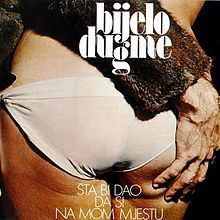Released 17 December 1975 Producer Neil Harrison | Length 34:22 Šta bi dao da si na mom mjestu(1975) Eto! Baš hoću!(1976) Release date 17 December 1975 | |
 | ||
Recorded AIR Studios, Oxford Circus, London8–23 November 1975 Similar Bijelo Dugme albums, Hard rock albums | ||
Šta bi dao da si na mom mjestu (trans. Wouldn't You Like to Be in My Place) is the second studio album from influential Yugoslav rock band Bijelo Dugme, released in 1975.
Contents
- Background
- Album cover
- Track listing
- Personnel
- Additional personnel
- Reception
- New Years performance for Tito
- Tour
- In popular culture
- Legacy
- Covers
- Songs
- References
The album was polled the 17th on the 100 greatest Yugoslav rock and pop albums list in the 1998 book YU 100: najbolji albumi jugoslovenske rok i pop muzike (YU 100: The Best Albums of Yugoslav Pop and Rock Music).
Background
After the huge commercial and critical success of Bijelo Dugme's debut album, Kad bi' bio bijelo dugme, and a successful tour that followed it, the band went to the Borike village in Eastern Bosnia in the fall of 1975 to work on the songs for the following album.
The album recording sessions started in November 1975, in London. The album was produced by Neil Harrison, who previously worked with Cockney Rebel and Gonzalez. The bass guitar on the album was played by the band's vocalist, Željko Bebek, as the bass guitarist Zoran Redžić injured his middle finger just before the album recording started. Nevertheless, Redžić is credited on the album, as he worked on the bass lines, and directed Bebek during the recording. At the time, in the same studios, Roxy Music worked on their album Siren. The members of the band on several occasions visited Bijelo Dugme's recording sessions, expressing that they liked what they heard.
During the album recording, the band recorded an English language song, "Playing the Part", which was not released on the album, but appeared on the promo single distributed to journalists. "Playing the Part" lyrics were written by Dave Townsend; Jugoton executive Veljko Despot, who stayed with the band in London during the album recording, looking for someone to write the English language lyrics, contacted an artists agency, which sent Townsend.
Album cover
The album cover was designed by Dragan S. Stefanović who had also designed the cover of the band's previous album. The photograph featured Zoran Redžić's girlfriend at the time.
Track listing
All the songs were written by Goran Bregović, except where noted.
Personnel
Additional personnel
Reception
The album was a huge commercial success in Yugoslavia, selling more that 200,000 copies.
After the first 50,000 records sold, Šta bi dao da si na mom mjestu became the first Yugoslav album to be credited as a diamond record. After selling more than 100,000 copies, it became the first platinum record in the history of Yugoslav discography, and after reaching the 200,000 copies mark it was branded simply as "2x diamond record". "Tako ti je, mala moja, kad ljubi Bosanac", "Hop-cup", "Ne gledaj me tako i ne ljubi me više", "Požurite, konji moji" and the title track all became huge hits.
New Year's performance for Tito
Right after the album's release, its initial promotion was scheduled to take place at a New Year's 1976 concert at Hala sportova in Belgrade along with Pop Mašina, Buldožer and Cod as opening acts. However, five days before New Year's, the band canceled after getting invited to perform for Yugoslav president Josip Broz Tito at the Croatian National Theatre in Zagreb, as part of the New Year's celebration being organized for him.
The performance for the 83-year-old president did not go according to what the band had expected, as recounted by Bregović:
Tour
The tour following the album release was very successful. It featured three sold-out concerts in Belgrade's Pionir Hall in early February 1976. The tour confirmed and furthered Bijelo Dugme's standing as the most popular band in Yugoslavia, a status they previously earned with the success of their debut album. Journalists coined and began frequently using the term "Dugmemanija" (Buttonmania) as the public in the socialist country observed a new cultural phenomenon.
In popular culture
The album's record sales as well as the enormous popularity of "Tako ti je, mala moja, kad ljubi Bosanac" among all strata of Yugoslav society, in addition to its heavy rotation on Yugoslav radio, prompted film director Soja Jovanović to include the hit song in her Television Belgrade-produced 1976 comedy TV film Izvinjavamo se, mnogo se izvinjavamo (Sorry, Terribly Sorry), centered around Milić Barjaktarević (played by Slobodan Đurić), a prizewinning farmer on his way to an agriculture fair in Belgrade while on constant lookout for a woman to marry and take back to his village. The song becomes somewhat of a plot point in a train scene when Milić turns on his pocket radio, hears "Tako ti je, mala moja, kad ljubi Bosanac", and instantly starts rocking out to it in a clumsy attempt of wooing his somewhat more refined fellow passenger Borka (Milena Dravić).
Legacy
The album was polled in 1998 as the 17th on the list of 100 greatest Yugoslav rock and pop albums in the book YU 100: najbolji albumi jugoslovenske rok i pop muzike (YU 100: The Best Albums of Yugoslav Pop and Rock Music).
The title track was polled in 2000 as the 68th on the Rock Express Top 100 Yugoslav Rock Songs of All Times list.
The 2014, author and director Dušan Vesić wrote a biography of Bijelo Dugme, entitled Bijelo Dugme: Šta bi dao da si na mom mjestu. In the book, Vesić wrote:
Covers
Songs
1Tako ti je mala moja kad ljubi Bosanac3:53
2Hop-cup2:19
3Došao sam da ti kažem da odlazim3:37
